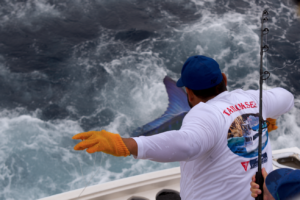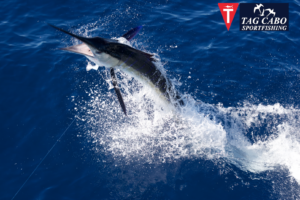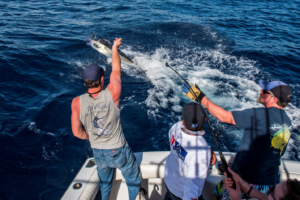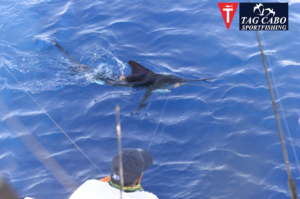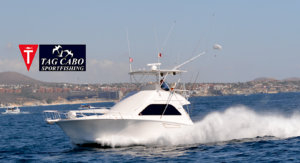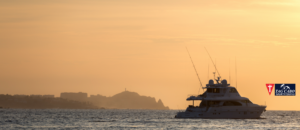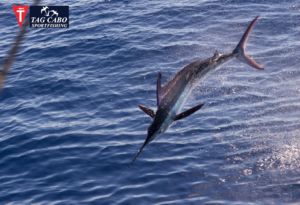Game Fish 101: Striped Marlins Game Fishing
With its elongated body, spear-point bill, and an extended, stiff dorsal fin, the Marlin fish belong to the Istiophoridae family of fish.
The name “Marlin” is thought be a consequence of the resemblance of the fish with marlinspike; an implement that sailors use to untie knots, splice up ropes, as a clasp used to join ropes and other purposes.
Marlins are fast swimmers, with a swimming speed of 80 kilometers per hour or 50 miles per hour; outshining their close relatives called Scombrids.
The family has approximately 10 species of Marlin. Common species include the sailfish (Atlantic and Indo-Pacific), Black Marlin, Atlantic Blue Marlin, Indo-Pacific Blue Marlin, White, Marlin, Striped Marlin, Short Bill Spearfish, Round Scale Spearfish, Mediterranean Spearfish, and Long Bill Spearfish.
While all Marlin genera have their unique appearances and interesting features, Striped Marlins are of particular interest if you are fond of game fishing.
Striped Marlin
Also known as striper, stripey, spearfish, and spike-fish, striped marlin is a commercial and game fish, caught for eating and activity purposes respectively.
Pelagic and seasonally nomadic, the species is found in tropical and mild temperatures in Indo-Pacific waters.
Pelagic zones are those which are neither close to the bottom of the sea, nor the shore, with temperatures ranging from 20 °C to 25 °C. These striped beauties live in these zones, thus are pronounced pelagic. Striped marlin fish also tend to travel away from the equator during warm season and towards the equator during cold season.
The habitat of the fish stretches from the west coast of the United States, South America, and Mexico across Pacific and Indian Oceans, and ultimately widening to reach New Zealand and Africa.
Striped Marlin fish grow to be huge and powerful which makes it a popular game fish. As the name indicates, the body of these fish has stripes with which they are distinguished from the rest. These cobalt blue colored stripes run vertically along the dorsal side of the body and are 10 to 20 in quantity.
The ventral side of the fish is white whereas the dorsal side is steely blue with bluish-silver upper flanks. These fish have a pair of ventral fins and an unusually elevated dorsal fin that’s the highest among all Marlin species.
Marlins with stripes grow up to 420cm in length and the average weight ranges from 60 to 120 kilograms.
Fun fact: A Striped marlin weighing 190 kg, with a length of 13.8ft was recorded in 1982.
Distinguishing Stripies from the Rest
- Physical Features:
Striped Marlin fish have prominent stripes and a touch of cobalt and steely blue.
- Sailfish versus Striped Marlins:
Both sailfish and Striped marlins are members of the family of fishes with sword-like bills (i.e. billfish). If the top of the fish you see has a sail like fin with accordion pleats, you are mistaking sailfish with stripies.
- Swordfish versus Striped Marlins:
Swordfish do have sword-like snouts, but have pectoral fins that are extended below the body and elongated, but more rounded body. On the other hand, Striped marlins have pectoral fins that are small and hardly noticeable and long, tabular bodies.
- Blue Marlins versus Striped Marlins:
A Blue Marlin has a dorsal fin no taller than half of the depth of its body, a rounder body figure (if you split it open, the slice would be more or less round), and a lower jaw that’s dwarfed and thick. On the contrary, Striped marlins have dorsal fins as tall as the entire body, shows an egg-like shape (oval shape) sawed in half, and a lower jaw that is lean and tapered.Striped Marlin as a Game Fish
Anglers that pursue fishing for recreational purposes opt for game fishing. Game fish that are caught during the activity can also be eaten later.
Game fishing started after the introduction of motor boats. A nautical biologist and early ecologist, Charles Fredrick Holder invented this sport in the year 1989.
Also known as offshore game fishing, offshore sport fishing, and blue-water fishing, Big-game fishing is a form of game fishing that targets large fish such as Striped marlins. Game fishermen regard Striped marlins as big fish with sport qualities.
99.9% of big fishing is done through trolling. Trolling is a method in which one or more fishing lines are attached to the boat to be drawn through the water. These lines have baits or lures attached to attract big fish.
Trolling could be done behind a moving boat or by leisurely winding the lines from a stationary position. The lines could also be swept from side-to-side to attract big fish.
Ballyhoo, a bait resembling fish of the halfbeak family, is very popular when it comes to catching Striped marlins.
Although no one will ever get a chance to interview Striped marlin on this subject, it is thought that spearfish such as Marlins are often full of squids and not hungry; yet a swift moving, shiny ballyhoo is enough to draw fish’s attention.
Big game fishing requires fishing in boats that are well outfitted and constructed for the sea, and has enough strength to move fish lovers from grounds to the sea and back.
Hiring suitable boats, buying fish tackle, fuel, consumables, and paying for anchoring fee, as well as other maintenance altogether make up a significant cost. Therefore, many fishermen and seasonal fishing fans choose to use charter services.
Cabo San Lucas -The Stripey Capital
Cabo San Lucas is a resort city located at the tip of Mexico’s Baja California peninsula. Standing high at the convergence point of two grand oceans; with the Gulf of California to the east and the Pacific Ocean to the west, it is an exemplary, rock-strewn cape. The cape is often known as the hub of Marlins.
Adjacent to the splendid cliff is a bountiful harbor named Los Cabos Marina, which serves as the launch point for world’s most productive Striped marlin fisheries. During spring season i.e. from mid-April to mid-June, the spot is more fruitful for Marlin fishing than it is in other seasons.
The waters of Baja get hit by Sailfish from April to October and Black and Blue Marlins between June and December, whereas Striped marlins are there irrespective of the months, all year round.
Due to the abundance of Marlins at Lucas, it has also been declared as the “Marlin Capital of the World”
All these features make Cabo San Lucas a clear-cut vacation spot and the best sport fishing waters in the world.
Fish Game in Cabo San Lucas, Mexico
If you use charter services when going for Striped marlin fishing, you do not have to worry about buying and using fishing tools, and checking for maintenance. You even get fish-finding guidelines from your captain who is an expert in the same.
For the ultimate, breathtaking landscapes of the ocean and wonderful fish game experience, nothing beats sailing through the waters in Cabo San Lucas in luxury yachts and fishing sport boats from the leading Cabo fishing charter company Tag Cabo Sportfishing. You Can Also read the Cabo fishing reports to know what to expect wile fishing in cabo.
What to expect from your big-game fishing excursion? What fishing techniques are used? What type of fish do we catch? What are the chances of us catching Striped marlins? What happens after catching the fish? These are some of the questions that might pop-up when thinking of pursuing charter services, but you do not have to fret when you are getting it done with professionals as such.
With several years of experience in booking yachts and sport fishing boats, arranging fishing activities is not a big deal for specialized, knowledgeable providers. Your sport fishing dreams literally come to life if you get you trip planned from the experts in the field.
Fishing Yachts
Several different types of yachts and boats are used for game fishing. These boats are categorized depending upon their size and the type of fish game they are best suited to.
Differently sized boats are designed to accommodate small, medium, and large groups of people coming for fishing and cruising purposes.
- 45 Feet Cabo Fly bridge
If you are looking for an extraordinary day with your family/friends and of course Striped marlins, the 45ft. Tail Chaser is a yacht that is commonly chosen. Picudo for sport fishing come with a wide range of fishing options that are customized to suit anglers’ needs.
Whether you are going for an offshore big-game fishing activity or catching smaller species in the shallow, Picudo can accommodate you.
The yacht has everything you need for fishing in Los Cabos. The yacht is stuffed with reels and tackles from Penn International and Shimano. You can also take a walk around the fly bridge that’s built in the 45ft. Picudo, to make fishing easier for you.
The boat has an inside salon area and a spacious cockpit. It can carry as many as 8 anglers at a time.
From Lucas to Magdalena Bay in Baja, MX
The lightly populated region of Magdalena Bay (Mag Bay) has been a hotspot for Striped marlins for years. The centre of the bay falls on the southwestern coast of the Baja cape and is heavily populated with stripies.
Mag Bay waters are faultless and full of life. Months starting October through January are the peak season for fishing in the bay. Being an offshore fishing paradise, the place gets crowded during the peak season with people fond of big-game fishing.
The bay has become the hub for anglers targeting Marlins as it produces these fish in numbers that are matchless anywhere else in the world.
La Paz & Espiritu Santo Island
Ages before people appeared on Cabo San Lucas in Baja, a large-scale natural event shook the part of the world where they now live. Mountains subsided, water levels fluctuated, there came floods, and some tiny pieces of land set in the middle of a turquoise sea. Two of such isolated lands between the seas were then named La Paz and Espiritu Santo Islands.
The gently leaning western shoreline of both the islands is like finger of a hand spreading wide. The water is crystal clear and the sand fine-grained. With beautiful landscapes, the coupled islands have become another spot you can visit. The islands are not well-populated with striped marlin, but are a good choice if you are looking to have a good family day with mild fishing.
Galapagos Island
Galapagos is considered the world’s top most destinations for wildlife viewing. Situated approximately 600 miles away from the coast of Ecuador, the Galapagos are another destination Marlin anglers drool over.
A man named Tarin LoCascio once landed a 250lbs striped marlin off the waters of the Galapagos. Striped marlin fish in Galapagos are considered to be the very best and when the times are good, it is common for anglers to have as many as 10 to 15 strikes a day.
The Ecuadorian government carefully protects the Galapagos because of it being a top attraction to tourists, visitors, and fishermen.
The place has stripers almost any time of the year, but is loaded with them from December to May.
The place has stripers almost any time of the year, but is loaded with them from December to May.
Sight Fishing Technique
Catching striped marlin through sight fishing is a very easy and effective technique. Because striped marlin often sails near to the water surface, you can easily locate them.
Gyro-stabilized binoculars utilize electronic position statistics to correct movements of the areas they are staged on.
Spending some extra money on binoculars is a good choice, especially is Southern California through Baja and Cabo San Lucas.
You have to make the most of binoculars to fish for striped marlin. The tail of the fish will appear dark against the sunny background when seen through these binoculars. Look around fiercely so that you do not miss out plump, beautiful stripers.
During warm-water months, this Pacific species come to hunt, feed, and unwind near the water surface. This is why sight-fishing or sight-casting for stripers intensifies in September and October.
For anglers who do not prefer getting gyro-stabilized binoculars, polarized sunglasses are crucial to have when going on a marlin hunt. Anglers who stay in the waters for long should carry two of these; one with amber lenses for cloudy skies and the other one for sunny conditions with gray tinted lenses.
You will sometimes see a quick flash of silver or blue instead of a dark shadow when stripers make movements on the surface. Keep the glare strong so that you don’t miss out on a good one.
Types of Striped Marlin
Dave Ferrell of Marlinmag says, “Striped marlin on the surface fall into three general categories: sleepers, tailers and feeders. That is until you hook one, then they become jumpers!”
- Sleepers
Almost motionless, a sleeper is found lying on the water surface and is typically the first type of striper you see in the morning. Your live bait should be very close to them to draw their attention.
It is suggested that sleepers should be targeted from behind or from the side so that you are able to cast in the right direction.
- Tailers
Striped marlin start roaming around the sea as soon as afternoon winds swing in. The activity of striped marlin riding the down the sea in the afternoon in known as tailing, and tailing fish are thus termed as tailers.
You will be able to spot tailers by checking on the pattern down-sea and looking through the troughs and swells that tailing marlins are surfing in.
- Feeders
Feeders are the most energetic striped marlins amongst the three. It is the fish that’s chasing live bait on the surface, often beneath the frigate birds.
Being active may be good for health, but surely not for feeder stripers as this leads them to get caught easily.
Best Offshore Lures
There is a variety of lures exclusively designed to catch offshore fish including striped marlins. Some of the best lures include:
- Mold Craft Super Chugger
Mold Craft Super Chugger is known for its curved-in face, which allows it to clutch a mouthful of air and let it out to form a thick bubble stream along with the movement of its head.
This lure has the ability to rise and fall quickly i.e. to and fro, which attracts stripers.
- Mold Craft Wide Range
With a centre nose and squared-off nose, the mold craft wide range lures have got the name from the wide range of speeds and conditions the lure can be pulled through.
- Copa Fishing Lures’ Tado
Tados are more like art pieces. They were introduced by Steve Coggin and are the lures that are highly regarded and effective. They are beautiful and large lures made with hand and are best for short corners.
- Pakula Lumo Sprocket
These lures are so good that an angler named Jody Wentworth jumped overboard to recover one of his sprockets that fell in the sea. Wentworth went 20 feet down the sea to recover his drowning lure.
This lures is made with tight swimming action and is best suited to outrigger slot, but works well in any condition.
- Tournament Tackle’s Ilander Lure (Hawaiian Eye)
This lure, also known as the Hawaiian eye, is the first to have lasting nylon skirts and realistic eyes. It is one of a kind and the first true high-speed trolling lure that was introduced in 1976.
This lure is best acknowledged for its versatility enabling fishermen to fish all types of marlin.
- Joe Yee Super Plunger
Super plunger has been an offshore item since 1994. This lure is said to be responsible for more 1000 pound marlins than any other lure in the fishing history. Joe Yee is extremely famous and widely used for big game fishing.
- Legend Lures Basilsik
Compared to other lures, Basilsik has a narrow face and angle which enable it to work well in rough conditions. The lure also has forms a bubble trail that is adored by captains who sale through marlin-rich waters.
Legend Lures can be used from short corners or long with up to 11 knots of trolling speed and 20 to 130 pound tackle.
Did You Know?
Here are some of the interesting facts of striped marlins which are not commonly known by us.
- Striped marlin is the smallest in size amongst the three species or marlin found in Australian waters.
- Unlike other fishes with stripes, the stripes of these fish stay even after the fish is dead.
- Stripers change colors of their stripes according to their mood. Yes, they can influence the colors with the level of excitement. Their usual dark blue stripes lighten and transform into lavender when the fish is thrilled.
- The average life span of a healthy striped marlin is 10 years.
- Solitary in nature, these fish like to live alone, but tend to form small groups during breeding season.
Last word: The more accurately you play the game, the more and the better striped marlins you get rewarded with. Plan it before you sail for it.

